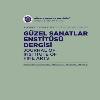Hyphantria cunea (Drury) (Lepidoptera: Arctiidae)’den İzole Edilen Bakterilerin İnsektisidal Aktivitesi
Amerikan Beyaz Kelebeği, Hyphantria cunea (Drury) sayısız konukçu bitkisi olan polifag bir zararlıdır. Bu çalışmada, H. cunea’nın bakteriyal florası zararlıya karşı mikrobiyal kontrol ajanı olabilecek yeni organizmaları identifiye etmek için araştırıldı. H. cunea’dan altı bakteri izole edilerek saflaştırıldı. Bakteriyal izolatların morfolojik, biyokimyasal, diğer fenotipik özellikleri (API 20E, API 50 CH, API Staph ve API Coryne) belirlendi. İlave olarak, 16S rRNA gen sekans analizi de yapıldı. Yapılan çalışmalar sonucunda izolatlar; Lysinibacillus sphaericus (Abk1), Bacillus amyloliquefaciens (Abk2), Staphylococcus sciuri (Abk4), Kocuria palustris (Abk6), Arthrobacter arilaitensis (Abk7) ve Microbacterium oxydans (Abk8) olarak tanımlandı. Bütün bakteriler H. cunea’nın üçüncü-dördüncü gömlek larvalarına karşı oniki gün boyunca test edildi. En yüksek insektisidal aktivite %30 ile L. sphaericus (Abk1)’dan elde edildi (p<0.05). Bu sonuçlar, L. sphaericus (Abk1)’un, H. cunea’nın mikrobiyal mücadelesinde dikkate alınabileceğini göstermiştir. Gelecekte, L. sphaericus (Abk1)’un patojenite zenginleştirme stratejileri (diğer entomopatojelerle veya insektisitlerle kombine edilmesi gibi) kullanılarak H. cunea üzerindeki etkinliğinin artırılması yönünde çalışmalar yapılacaktır.
Anahtar Kelimeler:
Hyphantria cunea, bakteri, biyolojik kontrol, zararlı, patojenite
Insecticidal Activity of Isolated Bacteria from Hyphantria cunea (Drury) (Lepidoptera: Arctiidae)
The fall webworm (Hyphantria cunea) is a polyphagous pest with numerous host plants. In the present study, the bacterial flora of H.cunea was investigated to identify new organisms that can be used as microbial control agent against the pest. Six bacteria were isolated and cultured from H. cunea. Some morphological, biochemical and other phenotypic characteristics (with API 20E, API 50 CH, API Staph and API Coryne kits) of bacterial isolates were determined. In addition, 16S rRNA gene region was sequenced. As a result of the studies conducted, bacterial isolates were identified as Lysinibacillus sphaericus (Abk1), Bacillus amyloliquefaciens (Abk2), Staphylococcus sciuri (Abk4), Kocuria palustris (Abk6), Arthrobacter arilaitensis (Abk7) and Microbacterium oxydans (Abk8). All bacterial isolates were tested for 12 days against third-fourth instar larvae of H. cunea. The highest insecticidal activity was obtained from L. sphaericus (Abk1) with 30% after application (p<0.05). These results indicate that L. sphaericus (Abk1) can be taken into account in the microbial pest control of H. cunea. In the future, further studies will be conducted by using pathogenicity enrichment strategies of L. sphaericus (Abk1) (ex. combining with other entomopathogens or insecticides) in order to increase the effectiveness on H. cunea.
Keywords:
Hyphantria cunea, bacteria, biological control, pest, pathogenicity,
___
- Abbott WS (1925) A method of computing the effectiveness of aninsecticide. J Econ Entomol 18: 265-267.
- Albayrak Iskender N, Örtücü S, Aksu Y (2012). Pathogenicity of three isolates of the entomopathogenic fungi Beauveria bassiana to control Hyphantria cunea (Drury) (Lepidoptera: Arctiidae) larvae. Kırgızistan-Türkiye Manas Üniversitesi, Fen Bilimleri Dergisi 2 (13), 16-21.
- Altschul SF, Gish W, Miller W, Myers EW, Lipman DJ (1990) Basic local alignment search tool. J Mol Biol 215: 403-410.
- Ben-Dov E, Boussiba S, Zaritsky A (1995). Mosquito larvicidal activity of Escherichia coli with combinations of genes from Bacillus thuringiensis subsp. israelensis. J Bacteriol 10: 2581-2587.
- Chandel K, Mendki MJ, Parikh RH, Kulkarni G, Tikar SN, Sukumaran D, Prakash S, Parashar BD, Shouche YS, Veer V (2013) Midgut microbial community of Culex quinquefasciatus mosquito populations from India. Plos One 8: 11.
- Geetha I, Manonmani AM, Prabakaran G (2011) Bacillus amyloliquefaciens: A mosquitocidal bacterium from mangrove forests of Andaman and Nicobar islands, India. Acta Trop 120: 155-159.
- Gupta AK, Nayduch D, Verma P, Shah B, Ghate HM, Patole MS, Yogesh YS (2012) Phylogenetic characterization of bacteria in the gut of house flies (Musca domestica L.). Fems 79: 581-593.
- Harley JP, Prescott LM (2002) Laboratory Exercises in Microbiology. Fifth Edition New York: The McGraw-Hill Compaines.
- Huang S, Sheng P, Zhang H (2012) Isolation and ıdentification of cellulolytic bacteria from the gut of Holotrichia parallela larvae (Coleoptera: Scarabaeidae). Int J Mol Sci 13: 2563-2577.
- Leroy PD, Sabri A, Heuskin S, Thonart P, Lognay G, Verheggen FJ, Francis F, Brostaux Y, Felton GW, Haubruge E (2011) Microorganisms from aphid honeydew attract and enhance the efficacy of natural enemies. Nat Commun 2: 1-7.
- Moar WJ, Pusztzai-Carey M, Mack TP (1995) Toxity of purified proteins and the HD-1 strain from Bacillus thuringiensis againts lesser cornstalk borer (Lepidoptera: Pyralidae). J Econ Entomol 88: 606-609.
- Mongodin EF, Shapir N, Daugherty SC, DeBoy RT, Emerson JB, Shvartzbeyn A, Radune D, Vamathevan J, Riggs F, Grinberg V, Khouri H, Wackett LP, Nelson KE, Sadowsky MJ (2006) Secrets of soil survival revealed by the genome sequence of Arthrobacter aurescens TC1. PLoS Genet 2: 2094-2106.
- Ozsahin E, Sezen K, Demir I, Demirbag Z (2014) Bacterial isolates from Palomena prasina (Hemiptera: Pentatomidae) include potential microbial control agents. Biocontrol Sci Techn 24: 1039-1051.
- Suryadi BF, Yanuwiadi B, Ardyati T, Suharjono S (2016) Evaluation of entomopathogenic Bacillus sphaericus isolated from Lombok beach area against mosquito larvae. Asian Pac J Trop Biomed 6: 148–154.
- Szczerba I (2003) Occurrence and number of bacterial from the Micrococcus, Kocuria, Nesterenkonia, Kytococcus and Dermacoccus genera on skin and mucous membranes in humans. Med Dos Mikrobiol 55: 67-74.
- Tamura K, Stecher G, Peterson D, Filipski A, Kumar S (2013) MEGA6: Molecular evolutionary genetics analysis version 6.0. Mol Biol Evol 30: 2725-2729.
- Tranchida MC, Riccillo PM, Micieli MV, García JJ, Rodriguero MS (2011) Isolation, characterization and evaluation of mosquitocidal activity of Lysinibacillus strains obtained from Culex pipiens larvae. Ann Microbiol. 61: 575-584.
- Weisburg WG, Barns SM, Pelletier DA, Lane DJ (1991) 16S ribosomal DNA amplification for phylogenetic study. J Bacteriol 173: 697-703.
- Yadav K, Dhiman S, Baruah I, Singh L (2011) Development of cost effective medium for production of Bacillus sphaericus strain isolated from Assam, India. Microbiol J 1: 65-70.
- Yaman M, Nalcacioglu R, Demirbag Z (2002) Studies on bacterial flora in the population of the fall webworm, Hyphantria cunea Drury. (Lep., Arctiidae). J Appl Entomol 126: 470-474.
- ISSN: 2146-1880
- Yayın Aralığı: Yılda 2 Sayı
- Başlangıç: 2000
- Yayıncı: Artvin Çoruh Üniversitesi Orman Fakültesi
